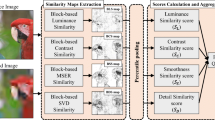Abstract
Although there is a lot of literature about generating HDR images, very limited research has been conducted on the issue of HDR image quality based on people’s feeling and preferences. The goal of this paper is to identify an objective quality measurement of an HDR image. The key features of HDR images that affect people’s preferences are uncovered through a survey in which testers judge different sample images of different scenes. The experimental results show that the proposed quality measurement for HDR images generates scores consistent with the true feelings of observers.


















Similar content being viewed by others
References
Debevec PE, Malik J (2008) “Recovering high dynamic range radiance maps from photographs.” In: Proceedings of the 24th Annual Conference on Computer Graphics and Interactive Techniques, pp. 369–378
Fattal R, Lischinski D, Werman M (2002) Gradient domain high dynamic range compression. ACM Trans Graph 21(3):249–256
Ghimire D, Lee J (2011) Nonlinear transfer function-based local approach for color image enhancement. IEEE Trans Consum Electron 57(2):858–865
Hanhart P, Bernardo MV, Pereira M, Pinheiro AM, Ebrahimi T (2015) Benchmarking of objective quality metrics for HDR image quality assessment. EURASIP J Image Video Process 1:39
Hu J, Gallo O, Pulli K, Sun X (2013) “HDR deghosting: How to deal with saturation?.” In: In Proceedings of the IEEE Conference on Computer Vision and Pattern Recognition, pp. 1163–1170
Hulusic V, Valenzise G, Provenzi E, Debattista K, Dufaux F (2016) “Perceived dynamic range of HDR images.” In: Proceedings of 2016 Eighth International Conference on Quality of Multimedia Experience, pp. 1–6
Jia S, Zhang Y, Agrafiotis D, Bull D (2017) Blind high dynamic range image quality assessment using deep learning. In: Proceedings of IEEE International Conference on Image Processing (ICIP), pp. 765–769
Krasula L, Narwaria M, Fliegel K, Le Callet P (2015) “Influence of HDR reference on observers preference in tone-mapped images evaluation.” In: Proceedings of Seventh International Conference on Quality of Multimedia Experience, pp. 1–6
Kumar VA, Gupta S, Chandra SS, Raman S, Channappayya SS (2017) No-reference quality assessment of tone mapped High Dynamic Range (HDR) images using transfer learning. In: Proceedings of 2017 Ninth International Conference on Quality of Multimedia Experience (QoMEX), pp. 1–3
Kundu D, Ghadiyaram D, Bovik AC, Evans BL (2016) “No-reference image quality assessment for high dynamic range images.” In: Proceedings of 50th Asilomar Conference on Signals, Systems and Computers, pp. 1847–1852
Kundu D, Ghadiyaram D, Bovik AC, Evans BL (2017) No-reference quality assessment of tone-mapped HDR pictures. IEEE Trans Image Process 26(6):2957–2971
Mantiuk R, Kim KJ, Rempel AG, Heidrich W (2011) HDR-VDP-2: a calibrated visual metric for visibility and quality predictions in all luminance conditions. ACM Trans Graph 30(4):40
Mertens T, Kautz J, Reeth FV (2009) Exposure fusion: a simple and practical alternative to high dynamic range photography. Comput Graphics Forum 28(1):161–171
Narwaria M, Silva MPD, Callet PL (2015) HDR-VQM: an objective quality measure for high dynamic range video. Signal Process Image Commun 35(1):46–60
Otsu N (1979) A threshold selection method from gray-level histograms. IEEE Trans Syst Man Cybern 9(1):62–66
“Photomatix (2018): https://www.hdrsoft.com/”
Singh G, Khosla A, Anwar MI (2016) “Spatial domain color image enhancement based on local processing.” In: Proceedings of 3rd International Conference on Signal Processing and Integrated Networks, pp. 265–269
Zerman E, Valenzise G, Dufaux F (2017) An extensive performance evaluation of full-reference HDR image quality metrics. Qual User Experience 2(1):5
Zhang Y, Chandler DM (2013) No-reference image quality assessment based on log-derivative statistics of natural scenes. J Electron Imaging 22(4):043025–043025
Author information
Authors and Affiliations
Corresponding author
Additional information
Publisher’s Note
Springer Nature remains neutral with regard to jurisdictional claims in published maps and institutional affiliations.
Rights and permissions
About this article
Cite this article
Lin, CY., Jheng, KR. & Shih, T.K. Objective HDR image quality assessment. Multimed Tools Appl 78, 1547–1567 (2019). https://doi.org/10.1007/s11042-018-6139-6
Received:
Revised:
Accepted:
Published:
Issue Date:
DOI: https://doi.org/10.1007/s11042-018-6139-6




